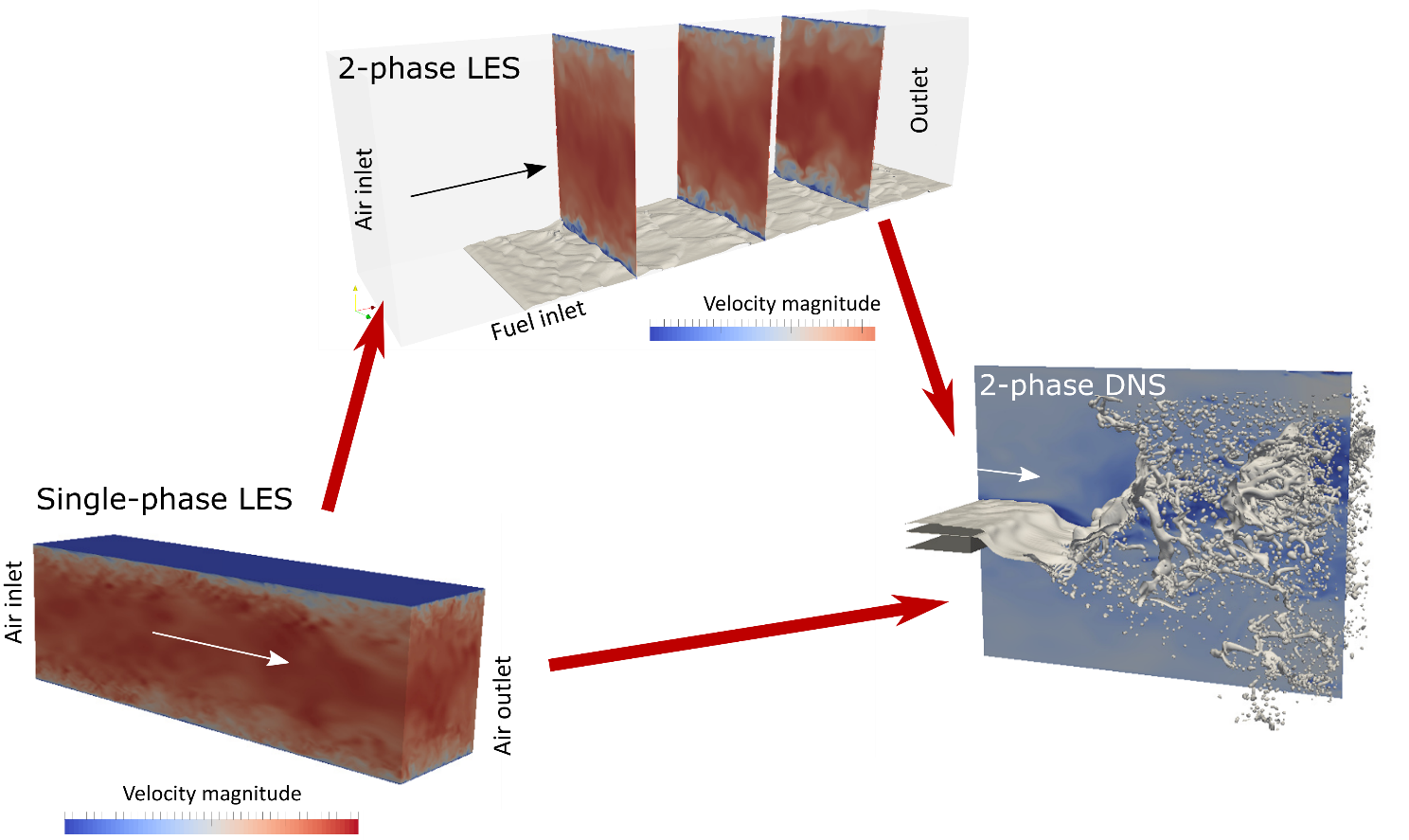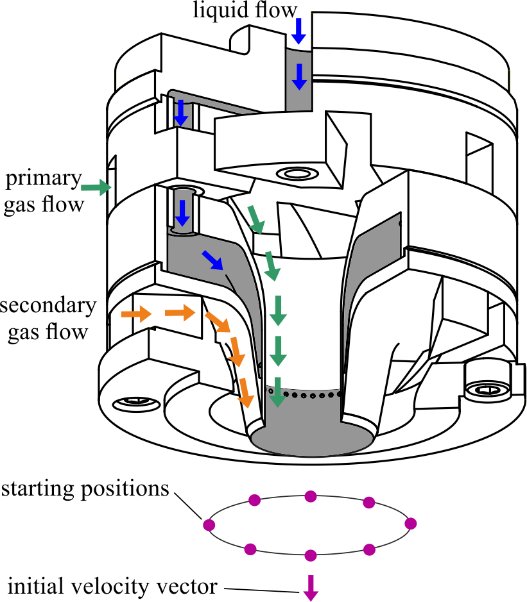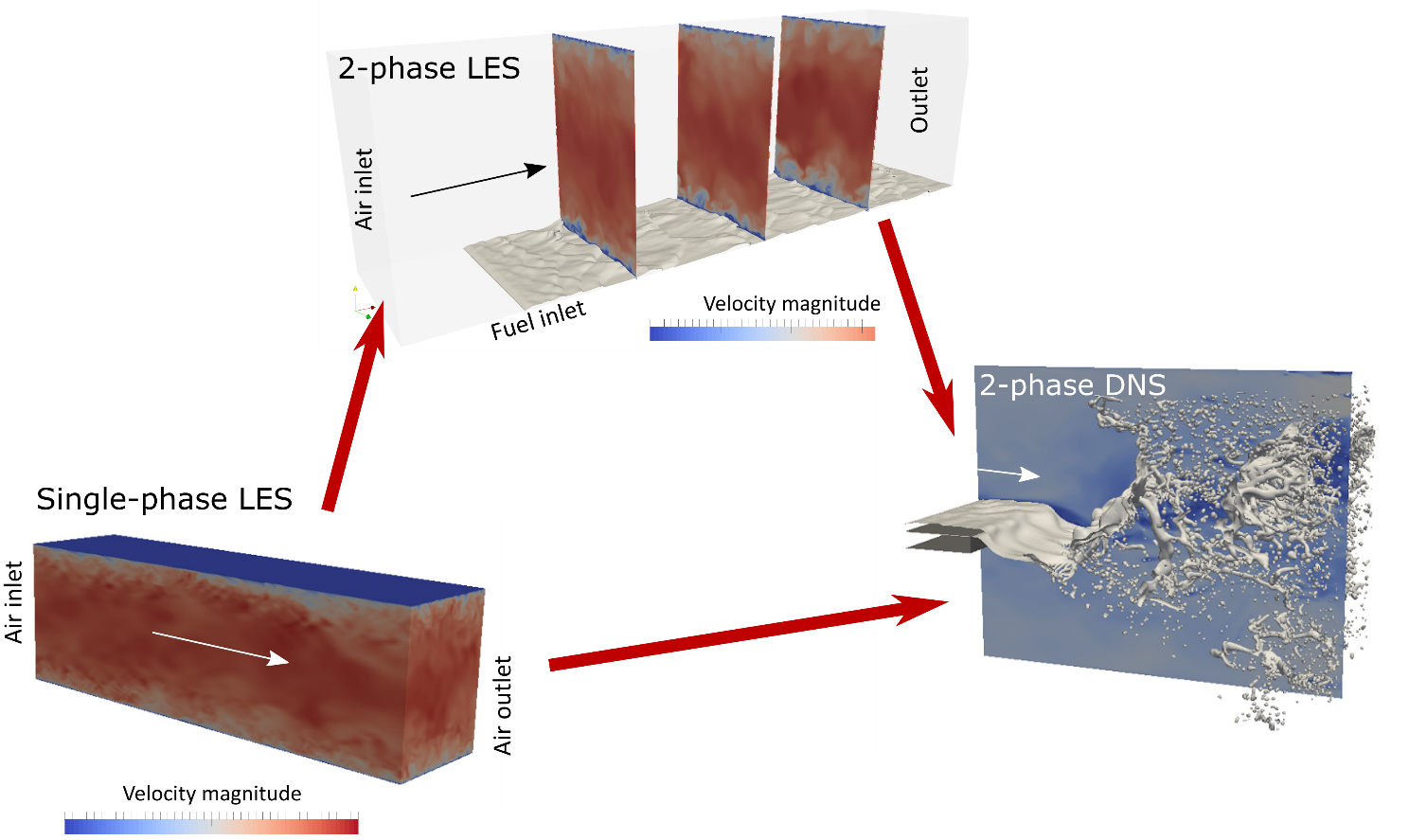
Air traffic growth raises concerns on the impact of pollutants on public health and climate change. ACARE has defined challenging goals with 5% reduction in CO2 aircraft emissions per passenger-kilometre and a 90% reduction in NOx. Turbofan engines thus demand combustion systems with low emissions.
In this context, the main objective of ESTiMatE is to develop a modelling strategy using Computational Fluid Dynamics (CFD) simulations for the prediction of soot in terms of chemical evolution and particle formation in conditions relevant to aero engine operation. Modelling realistic aero engine combustors is extremely challenging, as the simulations need to predict complex multiscale and multiphysics phenomena (Cuenot et al. 2016). The characterization of a spray flame includes the interaction of complex physical phenomena such as liquid fuel injection, primary breakup, spray dynamics, vaporization, fuel/air mixing and combustion.
Fuel injection and atomization play a key role in the environmental challenge. Great effort is placed to ensure the atomizers are able to effectively disintegrate the liquid fuel into ligaments (primary atomization) and then droplets (secondary atomization). These droplets must ultimately be small enough to promote fast evaporation and the formation of homogeneous fuel-air mixtures, which in turn increase combustion efficiency and reduce pollutant emissions. To do so, last generation turbofan engines make use of airblast atomizers, in which the fuel is first spread into a thin conical sheet (prefilmer) where it is dragged by a swirling high-velocity airstream until it is discharged at the atomizing lip. At this point, the induced instability leads to the fuel atomization.

Simulations concerning this application have traditionally used phenomenological models for liquid breakup, offering a compromise between accuracy and computational cost. These models have typically been developed based on generic experiments. However, most experimental works can only address the secondary atomization (Linne 2003) in regions far from the disturbance that produces liquid breakup.
The methodology proposed in ESTiMatE to address fuel atomization makes use of a Volume of Fluid (VOF) approach to simulate the liquid film formation and its breakup. These methods require a DNS frame to accurately predict the turbulence level at the origin of the primary instabilities in the liquids (Popinet 2009, Fuster et al. 2009). To this end, the open-source code ParisSimulator is used in the ESTiMatE project.
The simulation of complex geometries is unfeasible in the DNS framework. For this reason, the planar pre-filming geometry designed and experimentally studied at Karlsruhe Institute of Technology (KIT) (Chaussonet et al. 2019) is used for the VOF-DNS simulations, offering reliable data for validation. The DNS domain must be restricted to the vicinities of the atomizing lip, since the large range of involved length scales demands very fine grids. Hence, effort must be made to provide accurate inflow boundary conditions to the DNS simulations so that the turbulence is properly set to trigger wave instabilities and atomization (Sauer et al. 2016). In this regard, both single-phase and two-phase LES simulations of the prefilming channel are proposed as precursor simulations to map inflow data to the DNS. The novel approach in this project is the inclusion of the liquid film thickness evolution upstream of the atomizer lip in the DNS simulation.

The high-fidelity simulations are then able to supply detailed information on primary breakup that experiments cannot provide. The study of different operating conditions (varying the airstream velocity and the fuel properties) will allow the derivation by Universitat Politècnica de València (UPV) of a breakup phenomenological model specific for airblast injectors. The interest of this model resides in its industrial application: it is a reliable tool to couple to the RANS and LES simulations typically performed in the industry. The phenomenological model will thus be implemented by Barcelona Supercomputing Center (BSC) into the PRECISE-UNS CFD software developed by Rolls Royce, which is used for the design and development of future sustainable aero engine designs.
References:
Linne, M., “Imaging in the optically dense regions of a spray: A review of developing techniques”, Prog Energ Combust 39(5), pp 403-40, 2013.
Cuenot, B., Vickquelin, R., Riber, E., Moureau, V., Lartigue, G., Figuer, A., Mery, Y., Lamoroux, J., Richard, S., Gicquel, L., Schmitt, T., Candel, S., “Advanced Simulation of Aeronautical Combustors”, Aerospace Lab Journal, AL11-06, 2016 (online). Available at: http://aerospacelab.onera.fr/al11/advanced-simulation-of-aeronautical-combustors
Popinet, S., “An accurate adaptive solver for surface-tension-driven interfacial flows”, J Comput Phys 228(16), pp. 5838-66, 2009.
Fuster, D., Bague, A., Boeck, T., Le Moyne, L., Leboissetier, A., Popinet, S., Ray, P., Scardovelli, R., Zaleski, S., “Simulation of primary atomization with an octree adaptive mesh refinement and VOF method”, Int J Multiphas Flow 35(6), pp. 550-65, 2009.
Chaussonnet, G., Gepperth, S., Holz, S., Koch, R., Bauer, H.J., “Influence of the ambient pressure on the liquid accumulation and on the primary spray in prefilming airblast atomization”, Int J Multiphas Flow 125, p. 103229, 2019.
Holz, S., Braun, S., Chaussonnet, G., Koch, R., Bauer, H.-J., “Close Nozzle Spray Characteristics of a Prefilming Airblast Atomizer”, Energies 2019, 12, 2835.
Sauer, B., Sadiki, A., Janicka, J., “Embedded DNS concept for simulating the primary breakup of an airblast atomizer”, Atomization Spray 26(3), pp 187-215, 2016.
